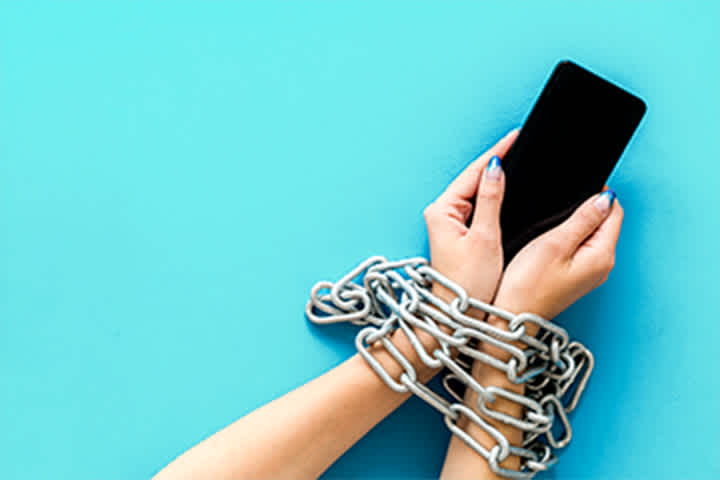How do you protect your smartphone from hackers?
Keytrade Bank
keytradebank.be
February 12, 2024
5 minutes to read
When it comes to cybercrime, your smartphone is firmly in criminals' sights. Once a device is connected to the internet – whether it's a laptop, smartphone, smart doorbell or fitness tracker – it becomes vulnerable to hackers.
What are the threats?
Some of the threats to your smartphone are 'just' a mobile version of the threats that desktops face. Mobile ransomware is one of these – a kind of malware that locks up your smartphone. Once your mobile device is infected, all access to any of the data on your phone will be locked until you pay a 'ransom'.
Depending on the type of ransomware, you may or may not temporarily lose your phone's call history, contacts, pictures, messages and other features. Even if you pay the ransom, there's no guarantee that your device will be released, let alone with your photos, contacts and messages intact.
Scareware is similar to ransomware, with the difference being that you can carry on using your phone. With scareware, the criminals use a pop-up or message to try and convince you that your smartphone is infected. Scareware often contains advertising for antivirus software. Yet downloading this 'software' will download the actual virus.
Not all malware is as visible as ransomware or scareware. Some malware is designed to pass unnoticed. This is spyware, a piece of software that's installed without your knowledge. This happens, for example, when you accidentally land on a site that secretly installs spyware on your smartphone while surfing. Once the spyware has been installed, the hacker can collect personal data (such as passwords), activate or disable functions on your phone, control your camera, and so on.
In the case of phishing, you receive an e-mail, a message in WhatsApp or Messenger, text message or other communication that apparently comes from a company or person you know. As an example, the message or e-mail may contain a link that leads to a fake website for your bank.
Cybercriminals can also hack your SIM card. They can do so by contacting your telephone provider, pretending to be you, and asking for a replacement card. As soon as the service provider sends them the new SIM card, the old SIM card is deactivated and your phone number is stolen. This means that the hackers can capture your phone calls, messages and more.
What can you do to protect your smartphone better?
Watch out which apps you download
Apple's App Store has around 1.85 million apps, and the Google Play Store over 2.5 million. Nowadays there's an app for everything. Yes, there's even an app that measures how high you can throw your smartphone into the air...Not all app developers' intentions are good, however. Some apps, for example, request access to your data under the pretence of improving your user experience. But what they really do is 'harvest' your data to sell it on. In the best case, this results in crazy advertising. In the worst case, your sensitive data may fall into the hands of criminals who use it to steal your identity.That's why you should always look for reviews of the app and the app developer online before you get it. Also remove any apps that you no longer use or that don't meet your expectations, allowing you to reduce the risks and gain storage capacity.
Don't use free Wi-Fi networks
It's nice that many airports, hospitality stores and supermarkets offer free Wi-Fi. However, these free networks can also pose a risk, as free Wi-Fi is often unprotected. This allows hackers to insert themselves between your smartphone and the Wi-Fi hotspot, and anything you do online can then be intercepted. So, it's wise to avoid all open networks. If you do take the risk, don't open any apps that contain sensitive data, such as your mailbox or banking app. Also regularly check the list of 'known' Wi-Fi networks on your smartphone and remove any you don't recognise.
Don't use public USB recharging points
If you charge your phone via a USB port, only use one that you trust, such as one on your computer or in your car. Cybercriminals can hack public USB ports (in airports, hospitality businesses, libraries and schools, for example).Use antivirus software
Just as you can download antivirus software for your computer, antivirus apps are available for your smartphone, too. In addition to protecting your phone from malware, some apps also offer additional features such as a password manager or blocking suspicious numbers.
Strong passwords and two-factor authentication
Creating robust passwords and storing them safely is essential for keeping cybercriminals away from your smartphone. You can find out how to do this properly by reading this article with tips from our security expert.An even better idea is to use two-factor authentication wherever possible when opening an app or approving actions. The first step is to log in with your password. In the second step, for example, your account sends a code to your smartphone that you can use to log in.Delete your search history and cookies regularly
By regularly cleaning up your virtual footprint, you give potential hackers less material to exploit.
Activate automatic updates
Update your apps and your smartphone's operating system on a regular basis. These updates are often necessary to plug security loopholes. The easiest way to do this is to activate automatic updates. If you never update your device, you leave the door open to hackers.
Check your bills and data usage
Hackers are usually hunting for cash. That's why it's good to check your accounts regularly. Higher data usage may also indicate that something's wrong.
Disable unnecessary functions
Disable all functions that you're not using at the time. This is especially important in public areas as hackers can also hack your phone via Bluetooth, for example. So, if you're not actually using your phone's GPS, Bluetooth or Wi-Fi, make sure you turn them off.Change your smartphone's access code regularly
Make sure you choose unusual number combinations. You can also use different codes to access the smartphone and individual apps. Also be careful with fingerprint and facial recognition, and make sure that no one else can register their fingerprint or face.Do not carry any (bank) cards in your smartphone case
If your phone is stolen, you'll be giving the thief a pleasant surprise! The same applies to any personal documentation, such as a driving licence or identity card.Activate the 'find my phone' function
You can activate the 'find my phone' function on smartphones with Android and iOS systems (Apple). If your phone is stolen, you can then block it remotely and delete all your data.
Be careful which devices you connect your smartphone to
If a PC is known to your smartphone, it can be used to access your data and/or back-ups. You should therefore only connect your smartphone to devices over which you have full and exclusive control.
Make regular back-ups and make sure they are secure
A back-up can help you restore data if you lose your phone or if it fails. Make sure that only you can restore the back-up by encrypting it, for example.
Check which privileges an app needs
Does the app you downloaded really need access to your contacts, photos or location data? And are you sure that your contacts are happy for you to share their contact details with a third party? Block whatever isn't essential.
Be cautious when maintenance, repair and replacement is needed
When you replace or stop using your smartphone, always delete all its data and configurations. This is best done by resetting your smartphone to the factory settings.And if you take your smartphone in to be repaired (if you've got a broken screen, for instance), be aware that the person will ask you for your access code so they can check it works. This means that you're giving the repair person access to all your data and apps (and sometimes the websites and passwords linked to them). It's therefore a good idea to change the access code for a short time. You can also limit the risk by only enabling certain functions on the phone and restricting the rest (by using Screen Time on iOS, for example). The safest thing to do is to create a back-up and reset your smartphone to its factory settings.


